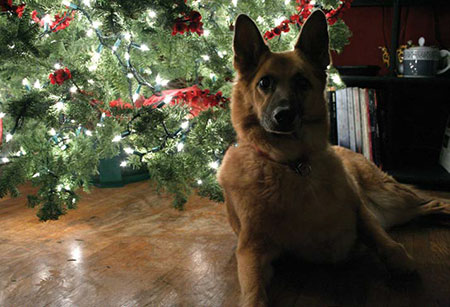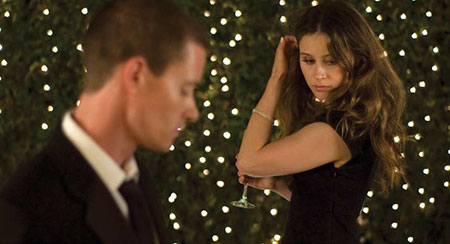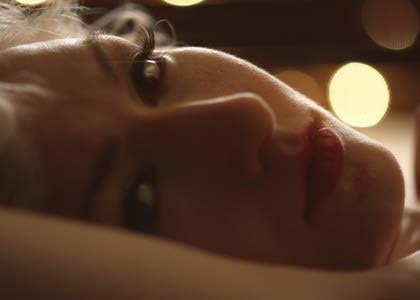’Tis the Season For Holiday Lights
LOS ANGELES—During the holiday season, you may find me scouring the aisles at my local hardware, home improvement and home superstores—not for holiday gifts, but for holiday lights!
The holidays are a great time for lighting professionals. What other time of year do we get to enjoy so many additional lighted decorations all around us? It’s also a great time to stock up on holiday lights for use year-round.
I love holiday lights. Aside from lighting my Christmas tree (and I light that baby with anywhere from 15–20 150 bulb strands each year—that’s 450–600 feet of lights!), I carry several strands of miniature clear lights with me on nearly every shoot. They’re phenomenal in the background or even as a key light.

The beautiful Ripley, excited for Santa to come. Here she is entirely lit from the holiday lights on the tree, which create a lovley large soft source in spite of their tiny size.
DOES SIZE MATTER?
Today, the variety of holiday lights is growing. Although I generally stay away from LED lights—as I prefer the warmth and quality of light from true-tungsten sources—there is a great variety available in true filament lights.
This starts with the miniature clear lights. These come in 25-, 50-, 100-, 150-and sometimes 200-light strands. I find the 150-light strands are most commonly available. Each 150-light strand is about 3 amps (40W). You can, generally, daisy-chain (wire in series) three strands together before you trip the fuse in the first strand.
If you are careful where you shop, you can find lights that are distributed along the string differently: 2.5 inches between lights, 4 inches or 6 inches are available. I usually go for green strands and the 4-inch variety.
Some people look at the larger bulbs as more traditional. C7 and C9 are the two most common sizes, with C9 being the larger of the two. C7 lamps are 2 1/8-inches high (base to tip) and 7/8-inch across at the widest point. They have E12 bases, which are small “nightlight” screw bases, commonly 5W per bulb. A C9 bulb is 2 7/8-inches high and is 1 1/8-inches at its widest point, commonly 7W per bulb, but are also avail-able in 10W per bulb.

Actress Lauren Waisbren in “Tom and Sophie.” Here, I used holiday lights purely as a background texture to put life and energy into the frame.
The larger bulbs really only come in straight strands, whereas the miniature bulbs have several varieties of strand configurations including “icicle” (where the bulbs hang in perpendicular strands of various lengths from the main power strand), or netting (where it is a chain-link kind of configuration made for draping over hedges).
In recent years the nostalgia for true-tungsten filament bulbs has risen as environmental causes were pushing them out. Several companies now offer the “Edison” variety of strand lights with beautiful warm filaments in various globe shapes and sizes.
HOLIDAY LIGHT APPLICATIONS
Holiday lights are great for many different applications. I have often taken strands of the miniature lights and run them behind the bottles of a bar, or under a countertop to provide some glow. I often would use them in candlelit scenes, wrapping the strands around an open 4x4 frame to create a large, warm source that mixes in beautifully with candles. I’ve used them in a “squished up” ball-like shape as a kind of “china ball” of light.

A shot from the opening title sequence of HBO’s “Femme Fatales” with model Heather Carr using holiday lights as background elements, especially in a very shallow depth of field.
Holiday lights run very warm, around 2,500K. They can be dimmed, but of course get warmer. The most common application is in the deep background or immediate foreground to create glowing orbs of light.
I also use them in every lens test in the background to test out the bokeh of the lens (the aesthetic quality of the blur produced in the out-of-focus parts of the image). Generally, I’m not a fan of the colored light sets, although they have their place. Mixed colors can be great in the background to give more life to your out-of-focus orbs.
On most jobs, I’d carry a box of single strands (about 20 or 30 strands in the box), a couple strands of larger C7 bulbs and a couple strands of net lights. That covers me for most any situation and gives me great variety with detail lighting.
Jay Holben is the author of the book “A Shot in the Dark: A Creative DIY Guide to Digital Video Lighting on (Almost) No Budget.” He can be reached at viaTV Technology.
Get the TV Tech Newsletter
The professional video industry's #1 source for news, trends and product and tech information. Sign up below.
